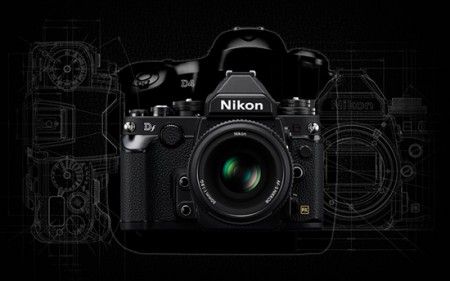
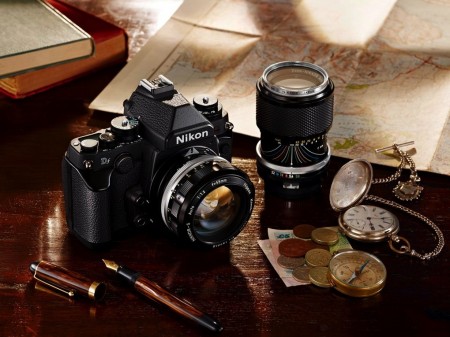


I’ve been intently watching the rumors trickle through up to today’s official release of the Nikon DF. The build-up lasted two weeks and included six overly dramatic, mostly annoying commercial shorts.
Like Fuji has been doing for the past few years with their X-series cameras, it seems Nikon wants in on the growing retro-inspired camera market. Nikon’s offering, however, comes across as a lot more serious than anything Fuji has released so far. The ‘Made in Japan’ camera uses the same full-frame 16.2 megapixel sensor and processing engine as their flagship D4 housed within a robust, dust and water resistant body. Interestingly, the camera omits any video capabilities and focuses on providing the dedicated photographer a dazzling array of mechanical dials. Just look at them – they’re beautiful!
Of course, this package doesn’t come cheap. Pricing is set at $2,746.96 for the body-only, and $2,996.95 with a special edition 50mm f/1.8 kit lens. You can expect this price to drop sometime after Christmas, but you have to wonder how willing people will be to buy the 16mp DF over the the fully-professional, 36mp Nikon D800e ($2,996.95 body only) or the now-oil-spot-free D610 ($1,996.95).
More images of the camera
(Edit: There is now a dedicated website for the camera: http://nikondf.nikonusa.com/df.html)
Posted by Owen


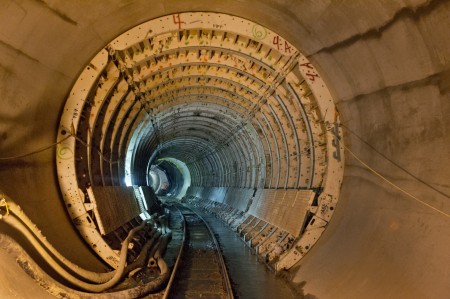


ISO 3200!!!
A captivating set of journalistic style images from the East Side Access project as of February 12, 2013. These images serve not only as a historical record of the tunnel’s construction, but as a stunning example of how far high-end DSLR cameras have come in handling high ISO images. All these images were shot between ISO 3200 – 5000 on a Nikon D4, and – more notably – at sharp apertures and shutter speeds. Images this clean under those lighting conditions simply wouldn’t have been possible even a few years ago.
Oh yeah, the tunnel is pretty neat, too.
(Edit: was asked why ‘billy j mitchell’ was in the last frame. But of course, it was to illustrate how much detail and tone remains in Billy’s skin at high ISO and in dim lighting.)
Posted by: Owen Perry



If you’re looking for a high end compact camera, the newly announced Nikon P7000 may just fit the bill. I’ve found myself leaving the full size SLR behind more and more lately so I’ve been thinking of filling the gap with something a bit more portable without sacrificing much in picture quality.
You can pick one up later this month for around $500. Plenty more info and specs over here.
Source Engadget



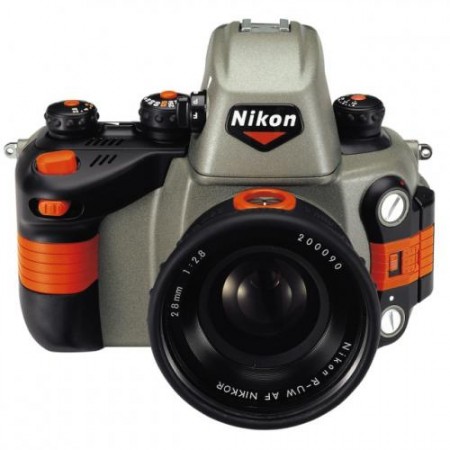
The normal, non-secret Nikonos RS
Gizmodo has an interesting piece up about a top-secret digital version of the now discontinued Nikon Nikonos waterproof camera that was developed for use by Navy SEALs.
This Nikonos was a total mystery. A secret that not many people knew about until recently. In fact, its existence was repeatedly denied by the manufacturer, even after the US Navy published this photo, showing a member of SEAL Team One equipped with one and the following caption:
980608-N-3236B-003 NAVAL AIR BASE CORONADO, California (June 8, 1998) — Navy SEALs attached to SEAL Team One, Naval Air Base Coronado, CA, conducts training using the Nikon/Kodak DCS 425 underwater digital camera which can send real time digital images to decision makers, and an LPI LPD tracking device uses brevity codes to send both mission status and precise longitude/latitude. U.S. Navy photo by Photographer Mate 2nd Class Ted Banks. (RELEASED)
– Gizmodo
Pretty interesting stuff and kind of odd to see the branding intact on the model used by the SEALs. The Gizmodo article makes a good point that it’s a shame the consumer version was discontinued; even if you don’t do underwater photography, it would make for an excellent no hassle all weather setup. More info and links can be found in the original article.
Apparently there’s a pretty good used market for these; all you aspiring SEALs can start planning your beach assaults with a nice rig like this. I’d like to see a digital model, but aesthetically I’m still partial to the original 35mm version:

Image via Dive Matrix
Via Gizmodo



The heat is coming down hard out here in California so I decided to do a limited run of the 77 shirt on the new American Apparel Tri-Blend Black. It’s super soft and super light for those long summer days. You can check them out at the ISO50 Shop: Men’s Shirt | Women’s Shirt.
On a side note, these are the first product shots I’ve done with all strobe flash lighting. I picked up a Nikon SB-900 and SB-600 and have been loving them. I still have a lot to learn but I am really happy with the initial results (see above; used SB-900 w/ diffuser on camera and remote SB-600 on stand w/ umbrella). I’ll be posting more on the flashes this week.




So I picked up some Nikon flashes last week and have been having a lot of fun with them. I got the SB-900 and its little brother, the SB-600. I’ve been running the 900 attached to the camera (D80) and have the 600 as a remote slave using Nikon CLS. Using the multiple flash setup has yielded some really great results (see this post for some examples) but even with just one flash attached directly to the camera I’ve found it’s pretty easy to get great shots.
Just thought I’d post some random shots I got playing around to illustrate how easy it is to get decent stuff using a good flash. I didn’t do all the post-processing stuff I usually do so you could see the raw output (save for the first one which I color filtered inside the camera). These were all shot with NEF RAW in adverse lighting conditions, most in very low incandescent light. As you can see, just the single flash was enough to fully light the scene and balance the color. If memory serves correct they were all taken with the SB-600 attached the camera. Also check out Alex’s post on the SB-600 for some other examples. As I work with the flashes more this week I will post more examples and info.



Recently I purchased a Nikon SB-600 flash for my D40. I have never owned anything in the way of photographic lighting and I figured this would be a good first step. I’ve outfitted my studio with a good continuous lighting set up (for video), but photographic lighting has always intimidated me (in regards to complexity and cost). The SB-600 is a flash attachment that works with the D40 (thankfully) and basically just augments the existing flash. The big difference is the ability to adjust the direction of the flash, allowing you to bounce light off the ceiling etc. It also has more options and allows for more control than the basic flash.
Above I’ve posted two pictures, the first uses the SB-600 (pointed at the ceiling), and the second is just the on-camera flash. Neither has been edited. Given that I have no idea what I’m doing with this flash, I think the results are fairly impressive out of the box. Every time I’ve used the SB-600 indoors, the pictures reflect exactly what I see in real life. None of that blown out flash nonsense. The colors are correct, the light is balanced, and the level of detail is like nothing I’ve seen come out of my D40 previously. Of course, the SB-600 is no substitute for a real studio lighting setup, but it’s a great way to cheaply augment the power and versatility of your on-camera lighting situation.
There are a number of other options for speedlights of this kind. I chose the SB-600 mainly because it seemed to be the best fit for my relatively “low end” D40. It’s not too heavy and didn’t break the bank like some of the other Nikon models (the SB-800 for example costs more than my camera). It’s been very easy to use and I would recommend it to anyone looking for a quick and easy way to improve their indoor photography. If anyone has experience with other models, Nikon or otherwise, I’d love to hear your thoughts or see some examples. I’m still learning how to get the most out of mine, but the potential definitely seems to be there.

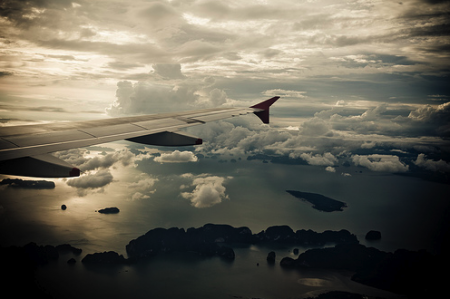



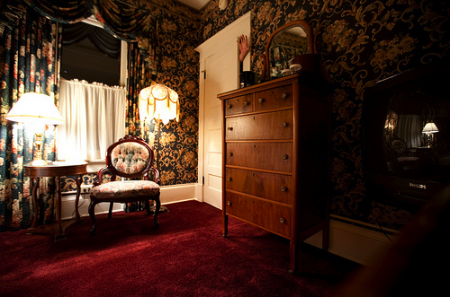

So I stumbled onto the deleteyourself blog the other day (same guy who runs Photololz) and in turn found his Flickr. There were some nice shots up there but what really struck me in particular was the vivid clarity and tone of the photos. So I took a look at the EXIF data and sure enough, they were all shot with a Canon 5D MKII. As you may well know, I have been trying to decide whether to stick with Nikon for my next camera or make the leap to Canon. I think that decision is becoming much clearer now; after seeing what Tim Navis did with the EOS 30D and now this, Canon is way out in front for me. Of course, he’s also using the $1500 Canon EF 16-35mm, but I suppose a camera like the 5D deserves only the best. At any rate, these shots drive home how good the 5D is at transforming otherwise mundane scenes into exquisitely detailed compositions of incredible depth and tonal range.
On a side note, that second pic looks like it was taken right around the same place I took this one, flying into Phuket Airport. I effected the hell out of mine, so it’s hard to compare the two, but I assure you that even in it’s raw form, mine was never anywhere near this detailed and dynamic. I’m not sure how much post processing he is doing with these, I’d love to know how much Photoshop had to do with the end results. Whatever the case may be, Photoshop can’t just synthesize out of thin air the kind of clarity and depth found in these shots; I would bet there’s just some simple color balancing going on. I’m also really liking the vignetting in a lot of these, can anyone out there with a similar rig testify as to whether that is a natural artifact of that particular lens or something he did in post?


































